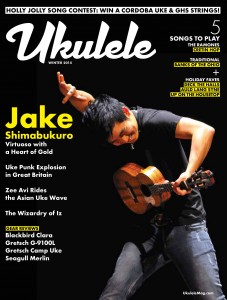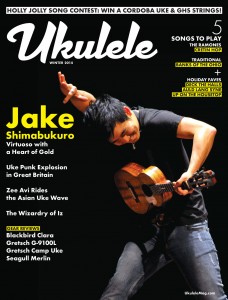Sunday, May 31, 2015
Tom Rosenthal – Non-Verbal Communication
Saturday, May 30, 2015
Tampa Bay Ukulele Society
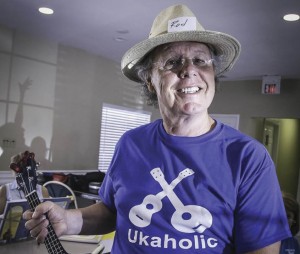
By Julie Garisto
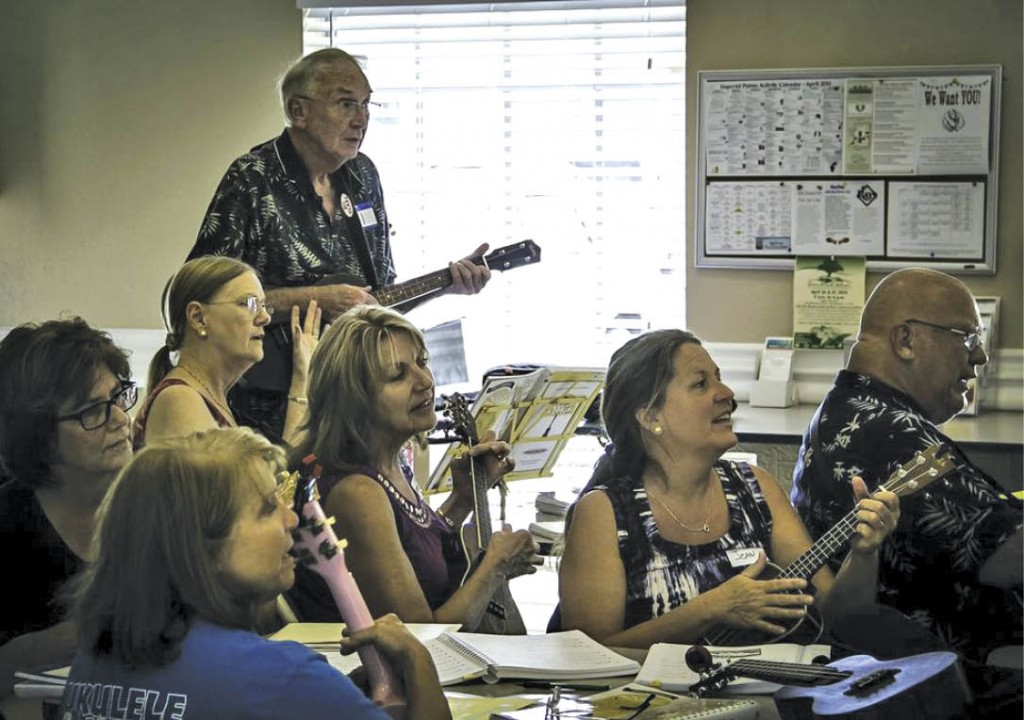
Tampa Bay Ukulele Society Members
On a balmy Saturday afternoon in Largo, Florida, a southern suburb of Tampa, 40 people have gathered with their ukuleles at a palm tree dotted apartment complex inhabited mostly by retirees. Excitedly chattering like high-school kids in a band class, the members of the southern chapter of the Tampa Bay Ukulele Society (TBUS) are called to order by 49-year-old jam-leader Jay Nunes. “Welcome back everybody—you ready to start? Neither am I,” he says with a good-natured grin, and the group launches into the Everly Brothers classic “All I Have to Do Is Dream.” The Largo chapter is just one of many chapters that meet up for jams across two Florida counties—together, they compose the Tampa Bay Ukulele Society. With nearly 700 members throughout central Florida, the larger group is the third biggest confab of uke players in the United States.
“I thought we’d get around a dozen or two-dozen players, not hundreds,” says Steve Boisen, 46, who founded the club in 2009. “Now we have non-profit status and a board of directors.” Boisen, who performs with his daughter in the uke duo the Barnkickers, conceived the TBUS as a place “for beginners to learn some new songs and techniques and for players of all levels to perform together in a supportive environment.” A Berklee College of Music alum and multi-instrumentalist, Boisen thinks the key to the group’s success is the accessibility of the uke. “People will start ukulele who are too intimidated to try other instruments,” Boisen says. “They will pick up a ukulele and play it with just a little practice.” The relative ease of playing a ukulele, Boisen argues, recalls a more primal time in our history, when music was something people just did.
For Boisen’s 22-year-old fashionable, yet folksy, daughter AmandaLynn, being a member ukulele community has become a big part of her life. Wearing glasses and a short brim fedora, she fits the part of uke ambassador perfectly. “My dad and I just fell into it,” she says. “It wasn’t preconceived. We got together with friends and said, ‘Well, let’s just form a club. It wound up becoming a doorway into a nationwide circuit.” Given the ukulele’s current wave of global popularity, there’s no doubt that the Boisens picked a good time to start a club. Steve notes that while the playability factor has helped draw people to the instrument, today’s generation isn’t encumbered by the instrument’s past baggage. “Young people today didn’t grow up with the stigma of Tiny Tim,” Boisen noted. “Cool bands, like Beirut, feature ukuleles now.” At the Largo jam session, however, the bulk of the club’s members are decidedly old enough to recall Tiny Tim’s antics, but didn’t seem the least put off. There are a fair number of single men in attendance, strumming soprano ukes and socializing. Retired couples share a common bond in their enjoyment of playing music at an age when some might assume people can’t learn a new instrument.

Rod Harrington
Occasionally calling out chord changes, Nunes leads players of all experience levels through renditions of “Runaway” by Del Shannon, “Cecilia” by Simon and Garfunkel, and “Folsom Prison Blues” by Johnny Cash. A veteran guitarist who has played in blues rock and cover bands, Nunes migrated to the ukulele after suffering a frightening mishap. “I was an iron worker and was knocked off a building by a crane swinging a load of steel onto the building,” Nunes shares. “I fell 20 feet and broke my ring finger on my left hand, which, in turn, needed a pin to fix.” In 2011, after his recovery, Nunes and his wife, Kelly, were “goofin’ around” in a local music shop, when he picked up a uke, started playing, and kept going for 45 minutes. “You didn’t complain once!” his wife told him. A few months later, she bought him his first ukulele, which he took to immediately.
A TBUS event organizer who oversees musicians with a nurturing, almost maternal approach, Norine Mungo hosts beginner sessions, and performs with her husband in an act called the Mungos. “I teach a method I developed over the years on the guitar,” Mungo says. “I call it, ‘Transitional Chording,’ and I basically treat the strings and frets as if it were a typewriter, not lifting their fingers off the frets. Once they get the sliding technique down, they begin to fly through the songs.” Mungo and other TBUS event leaders set up workshops throughout the year, and the group also organizes a concert series that features artists from across the country. “Recently, we had Stu Fuchs, and in February we had Flea Bitten Dawgs with Mike Hind, and in January we had Little Rev!” Mungo exclaims with a broad smile. “We keep the members very engaged.”
TBUS’s three-day Ukulele Getaway festival, which takes place November 7-9, is in its fifth year, and attracts such national headliners as Victoria Vox and the Jukes. Boisen says the event sells out right away because of the club’s “built-in audience.” AmandaLynn and Steve have experienced ukulele mania firsthand, both as club founders and while performing as the Barnkickers. Still, the recent popularity of the instrument can be overwhelming at times. “Anytime we play a festival, we’ll just look at each other and say, ‘Who does this?’” AmandaLynn says. “We’re playing ukuleles in Milwaukee, New York. This is so surreal—this is a thing!” Thanks, in part, to the Tampa Bay Ukulele Society, this is a very big thing in central Florida. “One thing that always happens at our Ukulele Getaway is that the hotel staff see how much fun we are having and a few of them wind up buying ukulele themselves,” Boisen says. “It’s that contagious.”
UkeTube
Friday, May 29, 2015
The Birth of the Ukulele

By Sandor Nagyszalanczy

“When did the Hawaiians invent the ukulele?” a friend of mine asked as I was giving her a tour of my collection of 430-plus vintage ukes.
The belief that Hawaii lays sole claim to the ukulele—the instrument that would seem to have grown up over centuries in relative obscurity among the descendants of the Polynesians—is a widely held misconception, and one that I’ve often been obliged to dispel. In fact, I informed her, the earliest ukes only date back to the mid-1880s. Then, pausing for effect, I added: “And they weren’t invented by the Hawaiians.” Looking like a six year old who has learned that Santa Claus doesn’t exist, my confused friend furrowed her brow and considered the ukuleles hanging on my wall anew. True, the actual history of the ukulele begins on an island, but not one in the Hawaiian chain, nor one in the Pacific Ocean, for that matter. Madeira, a small mountainous speck of land in the Atlantic southeast of Portugal, about a 350-mile swim from the coast of North Africa, is the actual birthplace of the beloved uke.
Not unlike the Hawaiian Islands, Madeira has a tropical climate and is part of a volcanic archipelago. The heavily forested island (Madeira means “wood” in Portuguese) once had a thriving timber industry and a long history of furniture making. But it’s probably best known for Madeira wine, the fortified, sherry-like beverage that became popular because it didn’t spoil on long sea voyages. Grape growing and winemaking have been a staple industry there since the 16th century.
Two centuries ago, Madeira was also a popular tourist spot for European visitors who were drawn to its picturesque landscapes and exotic flora. Visitors were often entertained by music played in the streets of Funchal, the island’s bustling port city. Because there were no encased windows on the houses in this hot climate, it must have been difficult to not hear strains of music, both day and night. Local musicians strummed waltzes, mazurkas, and folk tunes on the Spanish guitar and a small, guitar-like, four-string instrument called the machête (pronounced “ma-CHET”), also known as the braguinha or the “machéte de Braga” after the city in northern Portugal where the instrument originated.
Unfortunately, by the mid 1800s, Madeira wasn’t such a great place to be. Poverty, famine, and a series of natural disasters that led to the collapse of the wine industry made the island a better place to escape from than to. Scores of unemployed Madeirans sought to leave their overcrowded homeland and launch a new life elsewhere. It just so happened that as things were going wrong in Madeira, life was flourishing half a world away, in the Sandwich Islands—as the Hawaiian Islands were commonly known then—where the sugar industry was booming.
In 1874, Hawaiian planters shipped 25 tons of sugar to the mainland alone. But there was a problem: After decades of European colonization and introduced diseases, the native population was in decline, so there weren’t enough workers to man the plantations and factories. Desperation led planters to a worldwide search for labor, a search that eventually reached the Portuguese islands. Madeiran officials had no trouble finding men and women who were willing to sign three-year contracts to labor in the fields. In addition to wages of $6 to $10 a month, indentured emigrants would be provided room and board, as well as sailing passage to their new Pacific promised land.
Among the more than 25,000 Madeirans who came to Hawaii in the late 1800s, there were three woodworkers from Funchal: 40-year-old Manuel Nunes, 37-year-old Augusto Dias, and 28-year-old Jose do Espirito Santo. Joined by their families, the men packed aboard the 220-foot-long British clipper ship SS Ravenscrag, and embarked on the arduous four-month-long, 12,000 mile ocean journey to Oahu. Little did they know that this new adventure would not only bring them prosperity, but would lead to the creation of a new instrument.
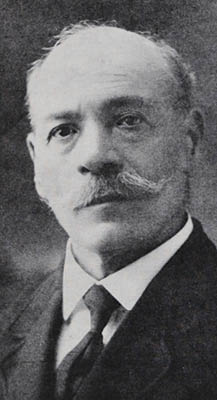
Manuel Nunes, Maderian woodworker and one of the pioneers of the Hawaiian ukulele
The poor, sea-weary immigrants finally arrived in Honolulu Harbor on a quiet Saturday in August of 1879. No sooner had they docked, when one of the passengers, an accomplished musician named Joao Fernandes, launched into a joyous song and dance to celebrate the ship’s safe arrival. Fernandes, a talented player who could reel off any song he’d heard only once, performed on a machête borrowed from a fellow passenger. He had also entertained the passengers during the long sea voyage, plucking out each song’s melody while the strumming the chords. Evidently, he wasn’t the only one who could play the instrument. Just a couple of weeks after the Ravenscrag’s arrival, the following item ran in the Hawaiian Gazette on September 3, 1879: “…Madeira Islanders recently arrived here have been delighting the people with nightly street concerts. The [m]usicians are fine performers on their strange instruments, which are a kind of cross between a guitar and a banjo, but which produce very sweet music in the hands of the Portuguese minstrels.”
Nunes, Dias, and Santo went to work on sugar plantations on Hawaii, Maui, and Kauai. After they’d fulfilled their contractual obligations, all three headed straight for Honolulu, the kingdom’s capital and center of commerce, with the ambition of returning to their former professions in woodworking. Fortunately for them, Honolulu had a flourishing furniture trade at the time, with more than a dozen local woodworking businesses. Nunes and Santo got jobs at Hawaii’s largest furniture store, the Pioneer Furniture House. Dias set up his own small woodworking shop in 1884, settling in Honolulu’s seedy, low-rent Chinatown district. He made not only furniture, but also musical instruments.
Within a year, Nunes had opened his own shop just three blocks away and both Diaz and Nunes were advertising their businesses in the local newspapers. Dias described himself as a “maker of guitars, machêtes, and all stringed instruments.” Nunes announced his business as a “cabinetmaker’s shop of stringed instruments, guitars and machêtes.”
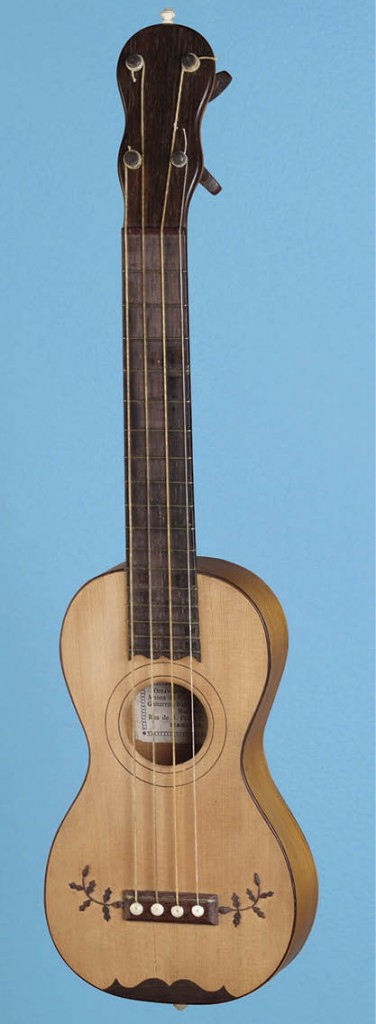
A machete made on the island of Madeira by Octavianno Joao Nunes da Paixao (1812–1874), one of Madeira’s most accomplished instrument makers
Santo soon followed suit, opening his shop just a few doors down from Nunes.
In addition to building instruments, all three eked out a living by reselling commercially-made instruments, doing repair work, selling strings, and so on. Dias even gave music lessons.
How did these three simple Madeiran woodworkers suddenly become luthiers? It’s unclear whether any of them had ever even built an instrument before coming to Hawaii. There’s some speculation (but no evidence) that Nunes may have been related to Octavianno Joao Nunes da Paixao (1812–1874), one of Madeira’s most accomplished instrument makers. The most likely explanation is that Nunes, Dias, and Santo all started building instruments while still pursuing general woodworking jobs, probably as a side business to earn extra money. Despite their lack of formal lutherie training, it’s clear from the quality of the instruments they built that these Madeirans knew what they were doing.
The first printed mention of an instrument clearly identified as a ukulele came just a decade after the Ravenscrag came to Oahu. So who actually built the first one? The honest answer is no one really knows! All three woodworkers built machêtes that looked a lot like ukuleles, and Santo advertised that he could “make guitars of all sizes.” Nunes claimed that he had invented the ukulele, boldly announcing this in newspaper ads and on his instrument labels.
Whatever part Nunes or Dias or Santo may have had on the creation of the uke, it’s most likely that the first true ukuleles were hybrid instruments: a mash up of the machête and another smallish Portuguese instrument, the five-string rajão (pronounced rah-ZHOW). The petite size and body outline of the machête, as well as its 17-fret fingerboard provided the basis for the ukuleles’ overall shape and configuration. But the machete’s D-G-B-D tuning wasn’t used. Instead, the ukulele employed the tuning of the rajão’s top four strings: G-C-E-A, minus its fifth string (a low D).
Why use this tuning?
“When and why [the tuning] was changed to my-dog-has-fleas is one of those little mysteries that always leads to more questions than answers,” the late-great musical historian John King wrote in his 2012 book The Ukulele: A History (University of Hawaii Press). Another important element that distinguishes Hawaiian ukuleles from their Portuguese brethren is the material they’re made from. Machétes and rajãos are typically built with spruce tops and bodies made of juniper and other light woods. Virtually all early ukuleles were made entirely from koa, a golden honey-brown wood prized by the Hawaiians and traditionally used for furniture and all manner of quality goods. Ukuleles, such as the one made by Jose do Espirito Santo, were, by and large, crafted from highly figured koa, and often had the same kinds of ornate decorations found on machêtes. Their tops and bodies are so eggshell-thin that these ukes are incredibly light and produce a great deal of sound for their diminutive size.
Having a unique name is something else that helps distinguish early ukuleles from other instruments, but exactly how the uke got its name is another mystery. There are many stories out there, but here’s one sensible explanation: Hawaii actually had the word “ukulele” before they had the instrument. An 1865 dictionary defined the word as “a cat flea,” a pest that had found its way to the islands decades earlier. Around 1900, novelist Jack London wrote that the ukulele was “the Hawaiian (word) for ‘jumping flea’ as it is also a certain musical instrument that may be likened to a young guitar.”
Six years later, the virtuoso uke player and teacher Ernest Kaai wrote in his ukulele instruction book that “the Hawaiians have a way of playing all over the strings . . . hence the name ukulele.”
Whatever the exact etymology of the word, the appeal for the instrument spread quickly, thanks, in part, to one of its earliest champions: David Kalakaua, Hawaii’s last king. Kalakaua, his Queen Emma, and the future queen Lili’uokalani (who composed “Aloha Oe,” that most sacred of Hawaiian songs) were all accomplished musicians and patrons of the arts. Their support and promotion of the ukulele encouraged other Hawaiians to take up the instrument and develop their own music and styles. In addition to featuring the ukulele at royal events, Kalakaua learned to play the uke himself and often included ukulele performances at his own informal gatherings.
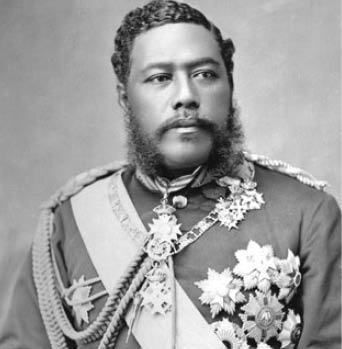
David Kalakaua, the last King of Hawaii and early champion of the ukulele
‘”We would go to the King’s bungalow,” musician Joao Fernandes told Paradise of the Pacific magazine in 1922, recounting Kalakaua’s parties, “Lots of people came. Plenty kanakas (native Hawaiians). Much music, much hula, much kaukau [slang for “food”], much drink. All time plenty drink. And King Kalakaua, he pay for all!’’
Clearly, King David earned the nickname by which he’s still celebrated today: “The Merrie Monarch.” As a new generation of Hawaiian ukulele makers set up shop—including Jonas Kumulae, who would bring the uke to the attention of mainlanders at San Francisco’s 1915 Pan Pacific International Exhibition and spark the world’s first uke craze—the original luthiers slowly faded into obscurity. By 1900, Santo had closed his shop, but continued to work at home for a few more years before he died. Dias lost his shop in a devastating fire that destroyed much of Honolulu’s Chinatown that same year. Nunes, the most prolific luthier of the three, continued building instruments for many years. He taught the art of ukulele making to numerous craftsmen, including his son Leonardo, who ran the Nunes factory in Los Angeles until 1930. Another of Manuel’s apprentices, Samuel Kamaka, started his own one-man shop in 1916.
Now, nearly 100 years later, the Kamaka Ukulele and Guitar Works on South Street in Honolulu carries on the legacy of three Portuguese emigrants who forever changed Hawaiian music and gave the world the gift of the “jumping flea.”
Sandor Nagyszalanczy is an avid ukulele collector and woodworking expert residing in Santa Cruz, California.
Ukulele chanteuses the Mersey Belles channel a retro vibe in pursuit of modern-day fun


The Mersey Belles
This may be the digital age, but the Liverpool ukulele duo the Mersey Belles still have one foot firmly planted in the stylish past. In fact, connecting with the two women—Danielle “Nancy” Perkins and Lindsey “Pearl” Stainthorpe—via Skype is like opening a window to 1940s England. Both are wearing navy-blue sailorette frocks, their hair done up in flawless victory rolls reminiscent of those once worn by actresses Ingrid Bergman and Mary Beth Hughes. Of course, the retro influence among ukulele players is in and of itself nothing new. Today’s uke scene is, one can argue, a tad preoccupied with bringing back the fashions and attitudes of past generations.
With a penchant for jazz standards and fondness for tiki culture, uke players love to pay tribute to bygone eras. And why wouldn’t they, considering the instrument’s many waves of popularity over the past hundred years? There’s something magical about those old, time-worn photos of original Hawaiian ukulele masters in their cross-cultural attire of leis and western suits, flappers playing ukuleles in ethereal lace dresses, or 1960s surfer guys plucking away in barkcloth Hawaiian shirts. That affinity for nostalgia is not lost on the Mersey Belles and—fortunately—it goes beyond retro fashion. Musically, the duo is best known for its beautifully harmonized renditions of jazz and pop songs from the first half of the 20th-century. Although these musicians have only been active for a little over a year, they’ve already grown a dedicated fan base in the United Kingdom, and begun writing their own material for their upcoming debut album. Finishing each others’ sentences as they discuss their desire to make their way to America, these graceful, talented women display an enthusiasm for music that is positively infectious.
How long have you played music together?
Nancy A year and two months.
So then this is your first project together.
Nancy We had a couple of mutual friends here in Liverpool because we both worked in music for quite a long time. We did run into each other on one job before this one, but we didn’t know each other.
What job was that?
Nancy We worked for Asda…is that Wal-Mart over where you are? It was like an advert promotion that we did together.
Pearl We sang in a choir.
You met each other more through your vocal work than the ukulele?
Nancy No, it was totally ukulele, actually, because, well, we didn’t really meet then, but we found each other, we’d realized that we’d both done that gig but we’d not really talked to each other.Pearl Because there were quite a few people in the choir.
Nancy But it was ukulele that brought us together.
So you both already had a passion for ukulele and for mid-century popular music by the time you met?
Nancy Yeah, I mean, I had this idea about a year and a half ago. I was working for a tea dance company over here in the UK. So my idea with that, because I was serving tea and cake to people dressed with victory rolls and pinafores—and I was given a ukulele because I sang on somebody’s album over here in the UK—basically I was thinking, wouldn’t it be great if you had two girls dressed in the same outfit with victory rolls playing the ukulele? So that was my brainchild about 18 months ago.
Along with the ukulele and your beautiful vocals, aesthetic is a huge part of the Mersey Belles.
Pearl Yes, definitely. This [gestures to her hair] takes an hour to do.
Nancy It takes her longer. It takes me a half an hour.
Pearl It’s worth it, and the getting ready is as enjoyable as the performing!
For each of you, what attracted you to the ukulele and how long had you been playing it before you became a duo?
Pearl I started on the guitar, and obviously it’s a transferable skill, so then I picked up a ukulele back in December 2012, and just loved it from then on.
Nancy As I briefly mentioned before, I sang on an album here in Liverpool for a local artist and to thank me for doing such a good job on the album, he actually gave me this beautiful Kala ukulele. It’s my favorite one. And I just started from there. The thing I really like about the ukulele is it feels really nice to play and it doesn’t feel too complicated or…I mean, we don’t claim to be amazing ukulele players, but we just really enjoy what we do.
And being technically proficient singers, the ukulele is a really good accompaniment for both of you.
Nancy We spend a lot of time on arranging our songs vocally. Because we know we’re not going to break into any, like, ukulele solos or anything like that.
Pearl We prefer to do more on the vocals and just use this as a tool to make a nice little plinky-plonk, you know, in the background.
What attracted you to doing mostly mid-century popular music? Was there anything in particular that you identified with in that style of music?
Pearl I think for me, I liked the simplicity of it, you know. I liked the beautiful sound that was created. I also liked the chord progressions as well, and a lot of the ’20s and the ’30s and the ’40s music used sevenths. I think they just make an awesome sound, and I think with our vocals, it’s pretty special, really. And that’s really why I really enjoy it. Plus, I love the look.
This style of music is popular for weddings, and I know you play a lot of weddings and similar events. You’ve definitely found a niche there.
Nancy Definitely, and we find a lot of brides these days are wearing vintage wedding dresses. And we played this amazing wedding last year that was in the middle of a forest, and that was just absolutely magical.
I understand you also recently played a christening.
Nancy Oh yeah, we do hen nights, christenings, twenty-firsts, bar-mitzvahs, everything.
Pearl We’ve been known to sign up to just do a little set in somebody’s living room.
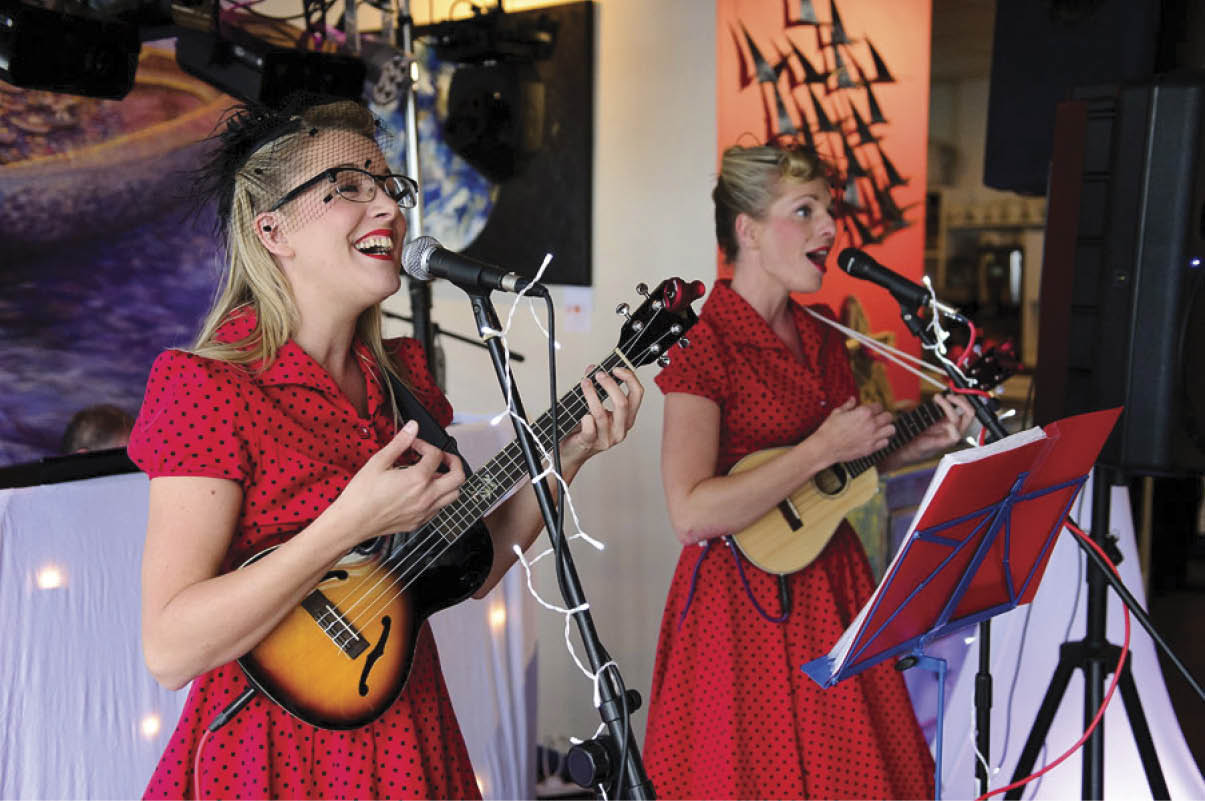
The Mersey Belles perform at “Oh Me Oh My” in Liverpool for the Liverpool iChoir event in January 2014
Do you have any plans to tour other parts of Europe anytime soon, or maybe even the US?
Nancy Because things are getting quite busy for us over here, we are actually currently in talks with a couple of management companies, and then the progression from there would be obviously to kind of start looking at Europe and the US, but we can’t really do that on our own. We have people interested in managing us, and we’re just trying to find the right person for us. Because it’s a big deal, isn’t it, to go in partnership? We go in partnership with each other, but it’s almost like you need to trust that person, so we’re on the lookout for representation at the minute. The right person, or people. From the beginning of this, what we both said is that we’re doing this to enjoy ourselves. We’re not taking ourselves too seriously, and we’re not divas. We really are in this genuinely for it, and the minute we start taking ourselves too seriously, I think…well, we’ll just never do that.
Pearl I completely agree. I think, you know, when you stop loving it because it gets too much, then you’ve got to question, really. And we really genuinely are in it for it, and we had such an amazing year last year in our first year, and this year has just gone crazy.
Nancy Oh, it’s mental!
How would you describe the current ukulele scene in the UK?
Nancy There’s a big thing happening here in Liverpool. There are so many ukulele bands here, and we know so many people down south. But we know all different types of ukulele bands, like the Ukuleighties, which is an ’80s covers band. And we have more traditional friends who do the ’20s stuff.
Pearl There’s loads of them, but they’re not purely ukulele. There’s a lot of clubs, there’s the Wirral Ukulele Orchestra, who are amazing. The Wirral area is just booming. Liverpool itself is just amazing. People tend to be quite stylized with it, I feel, because obviously with the George Formby thing. You know, he was from Blackpool, and we’re not far from Blackpool, so people have picked up on that and do play his style. Or, there’s a couple who do Roy Smeck. So people do lots of different things with the ukulele over here. But I think at the minute, we’re the only girls doing the duo.
Nancy We’ve researched all over and there are lots of trios, quartets, and quintets out there all over the world, but there’s no duos who do what we do.
Pearl Fingers crossed, touch wood. One thing to mention, actually, that’s really important that’s come out in the last couple of years: In school, when you were little, you would learn how to play a recorder. Today, they’ve all got ukuleles. They all start on ukulele. And we just think that’s fantastic.
Nancy It’s a ukulele boom.
When it comes to songwriting, how does that process work for you as a duo?
Nancy I think one of us has an idea like a melody or a strumming pattern or chord progression, and then we’ll come together with that. We’re basically considering writing with other people over here in Liverpool. We’re currently writing an album and we want the album to be amazing, to get us over to the States hopefully to promote it, you know what I mean? So we want to make sure that it’s really good, so, you know, we can get a record deal.
Pearl I think it’s all good and well singing other people’s songs and putting our own spin on them, but when you write your own song, you can just do what you want with it. That’s yours. You have full ownership on that song. And you can perform that to whatever degree you want. I think it’s stepping up the game as well a little bit for us. We’re hitting a different target audience. We’re looking at expanding our knowledge for what we can do as musicians.
Nancy I was just about to say, it gives you a lot more credibility, I think, if you can stand up and say “this is and album that we wrote between us.” And as we say, hopefully it will get us a nice, lovely tour in Europe and the States.
Pearl Oh, we hope!
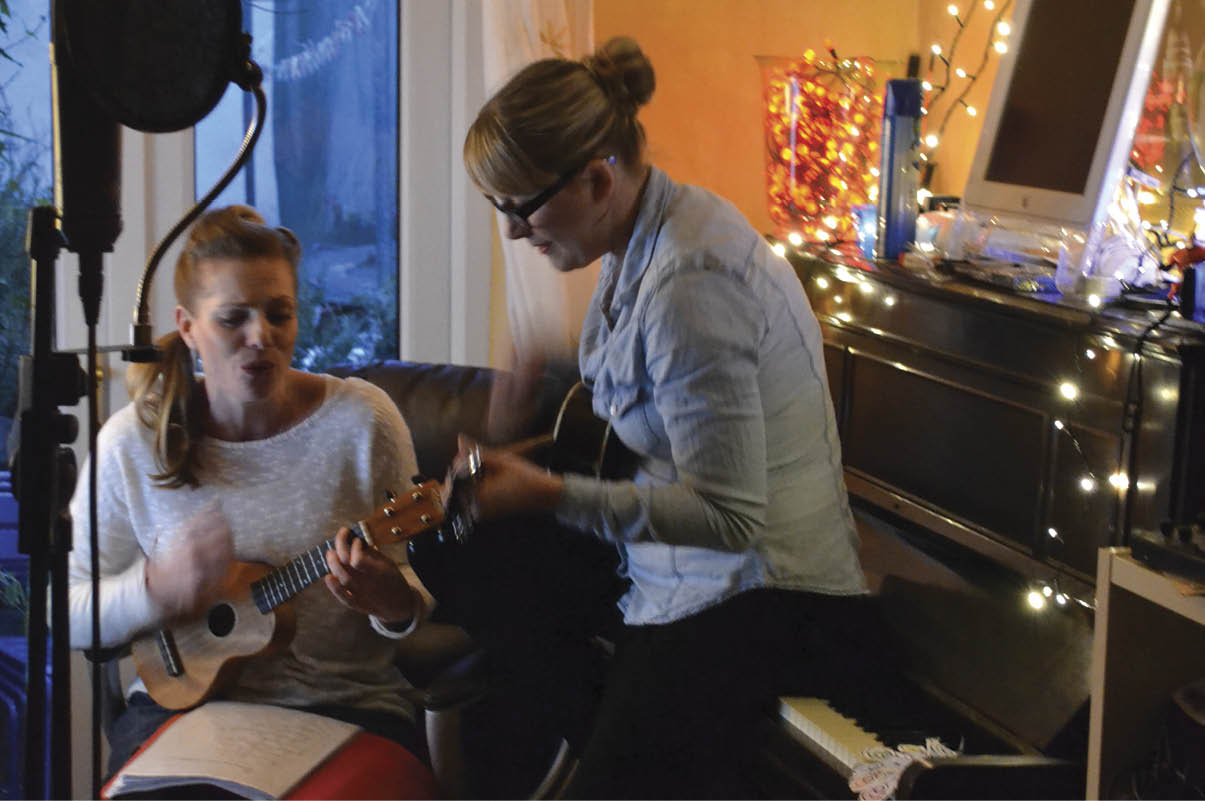
The Mersey Belles at home in Wirral
What The Mersey Belles Play:
Nancy
- Kala KA FMS 904
- Epiphone Les Paul Ukulele Cherry
- Kala KA-JTE/2TS acoustic-electric archtop
- Stagg USX-SPA-SE
- iUke mini ukulele
Pearl
- Kala soprano with redwood back and sides
- Clearwater acoustic-electric concert
- Stagg soprano with rosewood back and sides
Both use various types of Aquila strings, and favor Aquila Nylguts on their sopranos.
Thursday, May 28, 2015
How to play New Soul by 21 Songs in 6 Days: Learn Ukulele the Easy Way

Wednesday, May 27, 2015
How to play New Soul by 21 Songs in 6 Days: Learn Ukulele the Easy Way
Monday, May 25, 2015
Todd B – I Want Jesus on the Road I Travel
I want Jesus on the road I travel – Brother Joe May Cover – YouTube.
Note: There is a rating embedded within this post, please visit this post to rate it.Friday, May 22, 2015
Watch Jake Shimabukuro and Composer Byron Yasui Prep for Concerto World Premiere
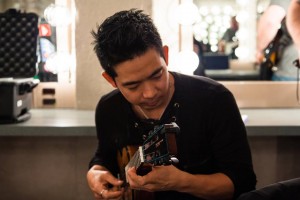
We’re counting the days, hours, and minutes until the world premiere of Byron Yasui‘s Concerto for ‘Ukulele and Orchestra, Campanella, to be performed by Jake Shimabukuro and the Hawai‘i Symphony Orchestra on June 6 and June 7. Watch in the above promo video as Shimabukuro and Yasui talk about the challenges of presenting a three movement ukulele concerto, which isn’t the first of its kind, but is definitely the most ambitious.
The Hawai‘i Symphony Orchestra commissioned Campanella to close its 2014-2015 Halekulani Masterworks season. Yasui, professor emeritus at the University of Hawai’i at Mānoa, wrote the concerto specifically with his Shimabukuro in mind, giving it the nickname “Concerto for Jake.” Shimabukuro will also perform Campanella this fall with the Colorado Symphony Orchestra, Virginia Symphony Orchestra, and the Buffalo Philharmonic. Fingers-crossed more tour dates will be announced—we’ll keep you posted!
Campanella premieres as part of the “Season Finale with JoAnn & Jake” concert on Saturday, June 6 at 8 p.m. and Sunday, June 7 at 4 p.m. at the Neal Blaisdell Concert Hall in Honolulu. Tickets are available at HawaiiSymphonyOrchestra.org.
How to Read Ukulele Tabs for This Land is Your Land - 21 Songs in 6 Days
How to Read Ukulele Tabs for "Amazing Grace" by 21 Songs in 6 Days: Lear...
http://youtu.be/lGx3lriWGkE How to Read Ukulele Tabs for Amazing Grace by 21 Songs in 6 Days: Learn Ukulele the Easy Way
Here's a new tutorial on how to play the melody to Amazing Grace. Amazing Grace is a beautiful sacred song that's also suitable for sing-a-longs - because almost everyone knows the words : ) We also have a lesson on how to sing and strum Amazing Grace at https://youtu.be/lGx3lriWGkE.
Amazing Grace is a Christian hymn published in 1779 by John Newton (1725–1807). Newton learned his trade sailing with his father from 1736 to 1742. He then enlisted as a crew member on a merchant vessel. A year later he was forced to serve in the British Royal Navy, a common practice at the time. He tried to escape the Navy but was caught and flogged 96 times in front of the ship’s crew of 350. Eventually he was able to transfer to another ship, but the crew did not like him. They left him in West Africa with a Amos Clowe, a slave dealer. Clowe gave Newton to the African Princess Peye who abused and mistreated Newton alongside her other slaves.
In 1748 a sea captain sent by his father rescued him. One night on his voyage home to England he awoke to find the ship filling with water during a violent storm. Just as he called out to God for mercy the cargo shifted enough to stop the leak, and he was saved from drowning. He later wrote that his spiritual conversion began at this moment. As he grew more committed to his religious faith he came to believe that the slave trade was wrong. He became a prominent abolitionist and evangelical religious leader and was influential in Britain’s abolition of slavery in 1807.
Amazing Grace is in 3/4 time so the feel, or swing, of the song is different from a song in 4/4 or Common time. When you are first learning the song, just use three downstrokes per chord for the 3 beats in each measure. When you know the song better, the down, down-up, down strumming pattern will make more sense. Here is a lesson video that will help to show and explain the strumming pattern and chords.
If you want to learn how to play ukulele, get your copy of ”21 Songs in 6 Days: Learn Ukulele the Easy Way” now at http://ukulele.io/Buy21Songs. You get a book and 60+ beginner ukulele lessons online at a private members only website.
Visit our website for more info, and sign up for FREE ukulele lessons in your email inbox...
http://ukulele.io/
Easy Ukulele Songs, ukulele tabs, how to read ukulele tabs, how to play ukulele tabs, Amazing Grace, Amazing Grace ukulele
How to Read Ukulele Tabs for "Auld Lang Syne" by 21 Songs in 6 Days: Lear...
https://youtu.be/0ge6_KU1scQ How to Read Ukulele Tabs for "Auld Lang Syne" by 21 Songs in 6 Days: Learn Ukulele the Easy Way
Here's a lesson video to help you learn how to read ukulele tabs. We hope the special formula will rocket you into fingerpicking melodies on your ukulele! We also have a video of how to sing and strum the chords to "Auld Lang Syne" at https://youtu.be/-YnoIy5pgVA
"Auld Lang Syne" is a Scots poem written by Robert Burns in 1788 and set to the tune of a traditional folk song. Well known worldwide, especially in the English-speaking world, Auld Lang Syne is traditionally used to bid farewell to the old year at the stroke of midnight on December 31st. It is also sung as a farewell or ending at funerals, graduations and other occasions. For example, the International Boy Scouts use it to close some of their meetings.
The song's Scots title may be translated into standard English as "old long since", or more idiomatically, "long long ago",[4] "days gone by" or "old times". "For auld lang syne" could be loosely translated as "for (the sake of) old times".
The phrase "Auld Lang Syne" is also used in similar poems written in the 16th, 17th and 18th centuries. And author Matthew Fitt uses the phrase "In the days of auld lang syne" as the equivalent of "Once upon a time..." in his modern retelling of fairy tales in the Scots language.
If you want to learn how to play ukulele, get your copy of ”21 Songs in 6 Days: Learn Ukulele the Easy Way” now at http://ukulele.io/Buy21Songs. You get a book and 60+ beginner ukulele lessons online at a private members only website.
Visit our website for more info, and sign up for FREE ukulele lessons in your email inbox...
http://ukulele.io/
Auld Lang Syne, Ukulele Tabs, How to play ukulele tabs
How to Read Ukulele Tabs for "Amazing Grace" by 21 Songs in 6 Days: Lear...
http://youtu.be/lGx3lriWGkE How to Read Ukulele Tabs for Amazing Grace by 21 Songs in 6 Days: Learn Ukulele the Easy Way
Here's a new tutorial on how to play the melody to Amazing Grace. Amazing Grace is a beautiful sacred song that's also suitable for sing-a-longs - because almost everyone knows the words : ) We also have a lesson on how to sing and strum Amazing Grace at https://youtu.be/lGx3lriWGkE.
Amazing Grace is a Christian hymn published in 1779 by John Newton (1725–1807). Newton learned his trade sailing with his father from 1736 to 1742. He then enlisted as a crew member on a merchant vessel. A year later he was forced to serve in the British Royal Navy, a common practice at the time. He tried to escape the Navy but was caught and flogged 96 times in front of the ship’s crew of 350. Eventually he was able to transfer to another ship, but the crew did not like him. They left him in West Africa with a Amos Clowe, a slave dealer. Clowe gave Newton to the African Princess Peye who abused and mistreated Newton alongside her other slaves.
In 1748 a sea captain sent by his father rescued him. One night on his voyage home to England he awoke to find the ship filling with water during a violent storm. Just as he called out to God for mercy the cargo shifted enough to stop the leak, and he was saved from drowning. He later wrote that his spiritual conversion began at this moment. As he grew more committed to his religious faith he came to believe that the slave trade was wrong. He became a prominent abolitionist and evangelical religious leader and was influential in Britain’s abolition of slavery in 1807.
Amazing Grace is in 3/4 time so the feel, or swing, of the song is different from a song in 4/4 or Common time. When you are first learning the song, just use three downstrokes per chord for the 3 beats in each measure. When you know the song better, the down, down-up, down strumming pattern will make more sense. Here is a lesson video that will help to show and explain the strumming pattern and chords.
If you want to learn how to play ukulele, get your copy of ”21 Songs in 6 Days: Learn Ukulele the Easy Way” now at http://ukulele.io/Buy21Songs. You get a book and 60+ beginner ukulele lessons online at a private members only website.
Visit our website for more info, and sign up for FREE ukulele lessons in your email inbox...
http://ukulele.io/
Easy Ukulele Songs, ukulele tabs, how to read ukulele tabs, how to play ukulele tabs, Amazing Grace, Amazing Grace ukulele
Hi Ho Mustachio – Eat your Broccoli
Thursday, May 21, 2015
Leftover Cuties – I Would
Wednesday, May 20, 2015
The Wizardry of Israel Kamakawiwo’ole
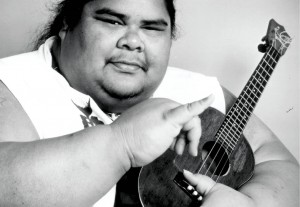
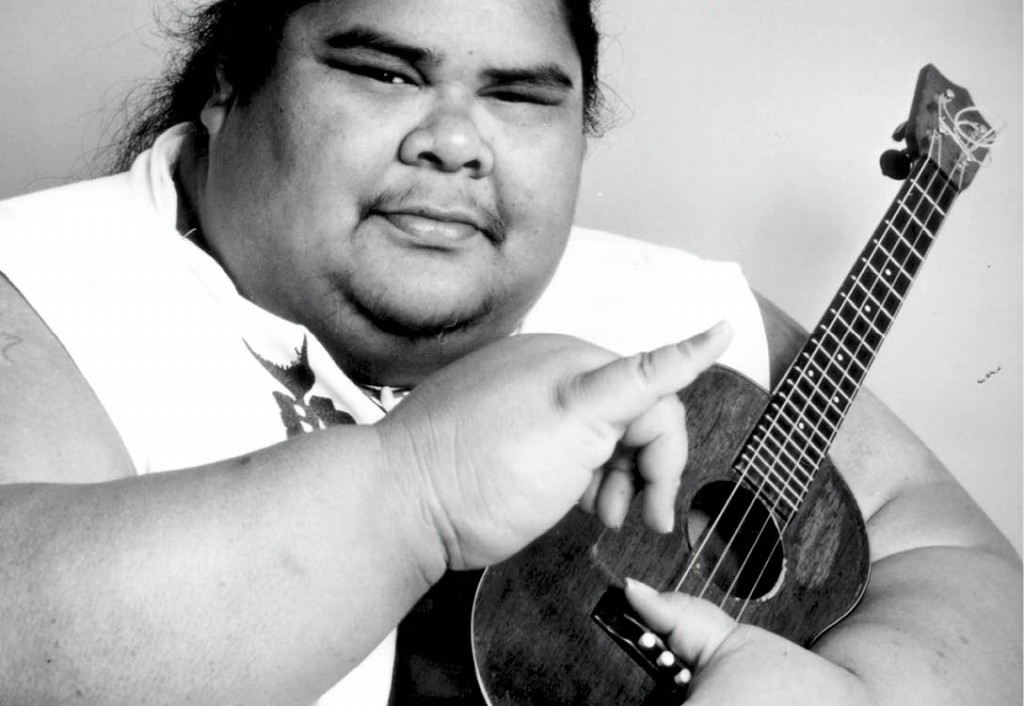
Israel Kamakawiwo’ole
By Dan Kois
The tiny ukulele never looked so small as when it was played by Israel Kamakawiwo’ole. Set against his massive frame—by the time of his death in 1997, he topped 757 pounds—Kamakawiwo’ole’s ’60s-style Martin tenor might easily have been mistaken for a toy or a punch line, but in his capable hands, it was the perfect instrument to elicit the intricate flourishes that Hawaiian music requires.
Kamakawiwo’ole—known to his fans simply as Iz—was intuitive and fluid on the ukulele. Even late in his life, singing and strumming with an oxygen tank by his side, his playing stood up to the virtuosos who joined Iz onstage, including guitarist Roland Cazimero and keyboardist Gaylord Holomalia. Iz played the occasional bum note—but in his nearly 20 years with the beloved group Makaha Sons of Ni’ihau, and in his short, but potent, career as a bandleader on his own, he wielded that Martin 1T with flair and good humor, coaxing songs from it that defined Hawaiian music for a generation of islanders. And with the success of his “Somewhere Over the Rainbow/What a Wonderful World” medley (released in 1993, and later featured on several TV and film soundtracks), Iz helped spark the ukulele renaissance in contemporary music.
The story behind this particular medley illustrates how much simply playing—in shows, at cookouts, and in one fateful impromptu recording session—was in Iz’s blood. He cut the song in 1988, in one take, in a downtown Honolulu studio where he’d never played, with an engineer he’d never met, at 3:30 in the morning. He was using coke and meth heavily in those days, and while the engineer, Milan Bertosa, could barely keep his eyes open, Iz was raring to go. He’d had a friend call Bertosa and beg for late-night studio time. When Iz showed up, clad in sandals and an aloha shirt the size of a tent, he had nothing with him but that Martin uke and a song he was dying to play. He waited patiently while Bertosa called building security to find a chair that could support his weight. Then he settled down, leaned into the mic, dedicated the song to the beloved Hawaiian musician Gabby Pahinui, and began strumming and oohing.
The spirit of performance that overtook Iz that night was one honed through tens of thousands of hours of music, starting when he learned to play the uke at the age of six. Family gatherings were musical affairs: his parents played and sang, and his uncle Moe Keale was a ukulele virtuoso, who was a member of Eddie Kamae’s legendary Sons of Hawaii band. At 11, Iz was accompanying his older brother Skippy on Waikiki tourist catamarans, playing hapa haole tunes for mainlanders as the sun set over the Pacific. Soon thereafter his parents got jobs at Steamboats, a Waikiki nightclub that was at the center of the Hawaiian music renaissance. When uncle Moe and the Sons of Hawaii performed, Iz and Skippy sat stage-side, occasionally being called up on stage to join them, happy to pocket the 20 bucks slipped to them at show’s end.
At other times, Iz and Skippy would hang out on Makua Beach on O’ahu’s west side, playing ballads in time with the waves breaking on shore. Eventually some local guys joined them, they started gigging parties, and the Makaha Sons of Ni’ihau was born.
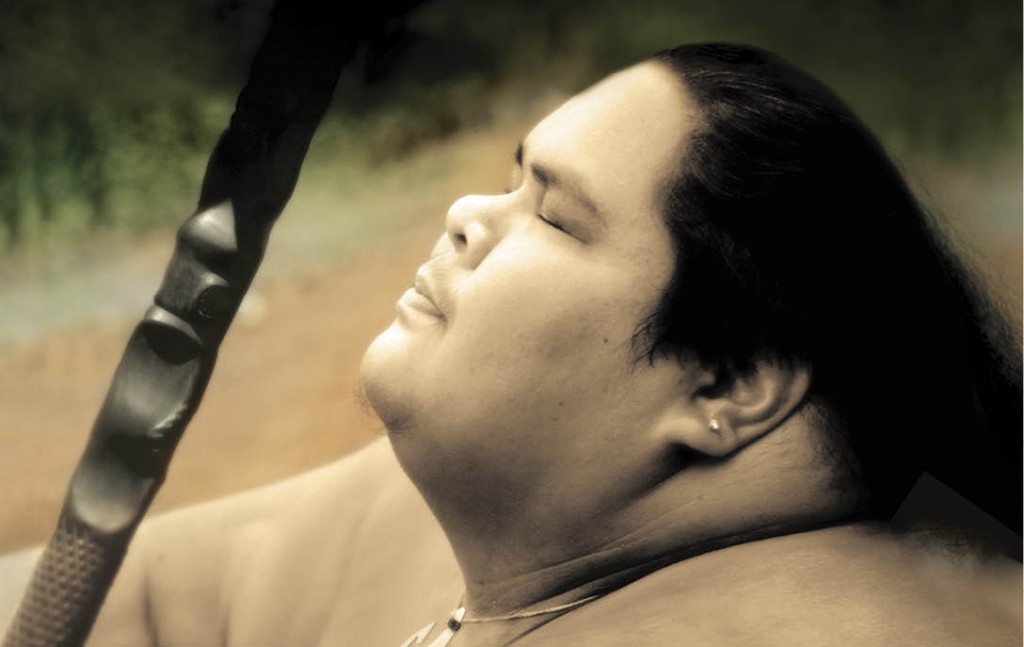
A careful listen to “Somewhere Over the Rainbow” reveals the casual, island approach that Iz brought to his playing. Though gemlike and perfectly formed in Judy Garland’s rendition, Iz didn’t mind changing up the lyrics, substituting “the dreams that you dare” for the line about birds flying over the rainbow. It might have been a mistake, but now it’s been replicated through a long chain of pop-culture covers in American Idol performances, movies, and ads. You could imagine a future in which Iz’s incorrect lyrics replace the original. When the song first started registering on the mainland, a rights supervisor called the Honolulu-based record label, complimenting them on their lovely version of the song and asking if perhaps they could have the artist re-record the track with the correct lyrics. “Well, I’d really love to,” said the company’s president, “but he’s dead.”
That the track even came to see the light of day was really just a lucky coincidence. Bertosa had been holding on to his cassette of the impromptu recording session for five years when he just happened to get hired as the engineer for Iz’s Facing Future sessions. Bertosa thought that Iz, by now hundreds of pounds heavier than in 1988, sounded bad, so he played the cassette for the album’s producer, saying, this is what he could sound like. Not to pass up a good thing, the “Somewhere Over the Rainbow” medley made it onto the 1993 release, and now you can hear snippets and versions in advertising jingles, movie soundtracks, twee indie-pop songs, or anywhere a producer wants an exotic feeling of wistfulness and wonder.
But don’t only remember Israel Kamakawiwo’ole for this hit song. Remember him as the big man making music with his Martin, carting it all over O’ahu, playing it on beaches and in bars, driving it around in his car, strumming it on stages and in hospital beds. The man and his uke got in trouble together, and they made great songs together. When Iz died, he cradled that little uke in his big hands one last time. They went into the fire together, and together they were scattered over the waves off Makua Beach.
Budapest - George Ezra (F)
No Funny Stuff Jug Band – Sofie Blue
Sofie Blue (Official NFS Video) – YouTube.
Thanks to Ron Hale.
Note: There is a rating embedded within this post, please visit this post to rate it.Monday, May 18, 2015
New Easy Ukulele Song Lesson Tutorial Video on Green Day's "Time of Your Life - Good Riddance" by 21 Songs in 6 Days: Learn Ukulele the Easy Way

Easy Ukulele Songs - Time of Your Life - 21 Songs in 6 Days: Learn Ukule...
https://youtu.be/JNt_xwuVl_k Easy Ukulele Songs - Time of Your Life Here's a nice easy version of 'Time of Your Life- Good Riddance' by Green Day. Jenny transposed it to C to make it lie better on the ukulele for the ukulele beginner.
It has a slightly complicated strumming pattern : down | down up | up down up. You can learn the pattern in another of our videos, "Learn Strumming Patterns with Jenny Peters" at https://youtu.be/0wLKsfhVN9Y?list=PL5meDCz5zO-DD1mcV8_t_tuga9MzOJA46.
Billie Joe Armstrong wrote "Good Riddance (Time of Your Life)" in 1990. But he didn't show the song to his bandmates until they were recording the album "Dookie" in 1993. Green Day decided that "Good Riddance (Time of Your Life)" was too different from the other songs on"Dookie" so they didn't use the song.
When Green Day began to record the album "Nimrod", Billie Joe Armstrong decided to use the song, and the band's producer Rob Cavallo suggested they add strings to the track. He sent the band to play foosball in another room while he recorded the strings, which took "like fifteen, twenty minutes, maybe a half an hour at the most." Cavallo reflected on his decision to add the strings "I knew we had done the right thing. It was a hit the second I heard it."
Band member Mike Dirnt says that the release of this song was probably the "most punk" thing they could have done. The song is more commonly promoted on the radio as "Time of Your Life", and it became a Billboard Country Rock chart-topper and an international hit, and was the only song from "Nimrod" that was a crossover success when released in single form.[6] Although "Time of Your Life - Good Riddance" was not issued as a physical single at the time of its original release in the United States, the song sold over 2.6 million copies as a digital download in the US. It's also certified Gold in the United Kingdom.
If you want to learn how to play ukulele, get your copy of ”21 Songs in 6 Days: Learn Ukulele the Easy Way” now at http://ukulele.io/Buy21Songs. You get a book and 60+ beginner ukulele lessons online at a private members only website.
Visit our website for more info. When you sign up for our mailing list at http://ukulele.io, we'll send you each new lesson video straight to your email in box. How convenient is that?
Happy Strumming!
best book to learn ukulele, easy ukulele songs, how to play ukulele for beginners, ukulele lessons, beginner ukulele songs, ukulele for beginners, learn ukulele, learn to play ukulele, ukulele lessons online, beginner ukulele, how to play ukulele chords, ukulele beginner, learn to play the ukulele, ukulele lessons online, ukulele music, playing the ukulele, ukulele teacher, Jenny Peters, Rebecca Bogart, the Ukulele Teacher, easy strumming songs, learn to strum
Heaven Sent - Best Coast (A)
Sunday, May 17, 2015
New Video Lesson on Easy Ukulele Song Scarborough Fair by 21 Songs in 6 Days: Learn Ukulel...
http://youtu.be/JaGopRKGDrs Easy Ukulele Songs - Scarborough Fair - 21 Songs in 6 Days: Learn Ukulele the Easy Way
Here's a great easy ukulele song - an traditional English tune about the Yorkshire town of Scarborough. Best part - it sounds great on the ukulele. Scroll to the bottom of the description for complete lyrics.
Some of the chords shapes are a little tricky - D, E7, G. If you don't know them, click on over to our playlist "How to Play Ukulele Chords" at http://www.youtube.com/playlist?list=PL5meDCz5zO-B8UjXstv_2WurNRGJyyWz8 for lots of helpful tips.
The strumming pattern is super easy - just down, down, down, etc. If you want to learn more complicated strumming patterns check out our playlist "Ukulele Strums" at https://www.youtube.com/playlist?list=PL5meDCz5zO-DD1mcV8_t_tuga9MzOJA46
Wait a minute! Isn't this song originally by Simon and Garfunkel? well, no, not according to Wikipedia. Versions of this ballad have been traced back as far as 1670. As the song spread, it was adapted, modified, and rewritten to the point that dozens of versions existed by the end of the 18th century, although only a few are typically sung nowadays. The references to the traditional English fair, "Scarborough Fair" and the refrain "parsley, sage, rosemary, and thyme" date to 19th century versions, and the refrain may have been borrowed from the ballad Riddles Wisely Expounded, (Child Ballad #1), which has a similar plot. A number of older versions refer to locations other than Scarborough Fair, including Wittingham Fair, Cape Ann, "twixt Berwik and Lyne", etc. Many versions don't mention a place and have more general titles like "The Lovers' Tasks", "My Father Gave Me an Acre of Land", etc.).
Again, based on Wikipedia, Paul Simon learned the song in London in 1965 from Martin Carthy, who had picked up the tune from the songbook by Ewan MacColl and Peggy Seeger. It was the lead track of the 1966 album "Parsley, Sage, Rosemary and Thyme", and was released as a single after being featured on the soundtrack to The Graduate in 1968.
The copyright credited only Simon and Garfunkel as the authors, causing ill-feeling on the part of Carthy, who felt the "traditional" source should have been credited. This rift remained until Simon invited Carthy to perform the song with him as a duet at a London concert in 2000. Simon performed this song with The Muppets when he guest starred on The Muppet Show.
Before Simon had learned the song, Bob Dylan had borrowed the melody and several lines from Carthy's arrangement to create his song, "Girl from the North Country", which appeared on The Freewheelin' Bob Dylan (1963), Nashville Skyline (1969) (together with Johnny Cash), Real Live (1984) and The 30th Anniversary Concert Celebration (1993).
Here are the complete lyrics:
Male part-
Are you going to Scarborough Fair?
Parsley, sage, rosemary, and thyme;
Remember me to the one who lives there,
For once she was a true love of mine.
Tell her to make me a cambric shirt,
Parsley, sage, rosemary, and thyme;
Without any seam or needlework,
Then she shall be a true love of mine.
Tell her to wash it in yonder well,
Parsley, sage, rosemary, and thyme;
Where never sprung water or rain ever fell,
And she shall be a true lover of mine.
Tell her to dry it on yonder thorn,
Parsley, sage, rosemary, and thyme;
Which never bore blossom since Adam was born,
Then she shall be a true lover of mine.
Female part-
Now he has asked me questions three,
Parsley, sage, rosemary, and thyme;
I hope he'll answer as many for me,
Before he shall be a true lover of mine.
Tell him to buy me an acre of land,
Parsley, sage, rosemary, and thyme;
Between the salt water and the sea sand,
Then he shall be a true lover of mine.
Tell him to plough it with a ram's horn,
Parsley, sage, rosemary, and thyme;
And sow it all over with one pepper corn,
And he shall be a true lover of mine.
Tell him to sheer't with a sickle of leather,
Parsley, sage, rosemary, and thyme;
And bind it up with a peacock's feather,
And he shall be a true lover of mine.
Tell him to thrash it on yonder wall,
Parsley, sage, rosemary, and thyme,
And never let one corn of it fall,
Then he shall be a true lover of mine.
When he has done and finished his work.
Parsley, sage, rosemary, and thyme:
Oh, tell him to come and he'll have his shirt,
And he shall be a true lover of mine.
Thanks for reading and we hope you like the lesson.
If you want to learn how to play ukulele, get your copy of ”21 Songs in 6 Days: Learn Ukulele the Easy Way” now at
http://ukulele.io/Buy21Songs
Visit our website for more info, and sign up for FREE ukulele lessons in your email inbox!
http://ukulele.io/
ukulele songs, easy ukulele songs, beginner ukulele songs, best book to learn ukulele, Simon and Garfunkel
Easy Ukulele Songs - Scarborough Fair - 21 Songs in 6 Days: Learn Ukulele the Easy Way

Friday, May 15, 2015
Easy Ukulele Songs- Bill Bailey - 21 Songs in 6 Days: Learn Ukulele the ...
http://youtu.be/HtkGM78wzJc Easy Ukulele Songs- Bill Bailey - 21 Songs in 6 Days: Learn Ukulele the Easy Way
Here's a fun oldie that sounds great on the ukulele. If you don't know all the chords, check out our playlist https://www.youtube.com/playlist?list=PL5meDCz5zO-B8UjXstv_2WurNRGJyyWz8.
Like the intro and outro music? Learn it here https://youtu.be/YznUjC8pnUQ
If you want to learn how to play ukulele, get your copy of ”21 Songs in 6 Days: Learn Ukulele the Easy Way” now at http://ukulele.io/Buy21Songs. You get a book and 60+ beginner ukulele lessons online at a private members only website.
Visit our website for more info, and sign up for FREE ukulele lessons in your email inbox...
http://ukulele.io/
Easy Ukulele Songs- Bill Bailey - 21 Songs in 6 Days: Learn Ukulele the Easy Way New Video Lesson

Wednesday, May 13, 2015
M Shanghai and Kelli Rae Powell – Bury Me In Iowa City
Jonathan Mann – Don’t Let Your Kids Join The Sharing Economy
Tuesday, May 12, 2015
Midnight Special - Creedence Clearwater Revival (D)
"Simple Gifts" New Easy Ukulele Video Song Lesson
 http://youtu.be/KXogGms6WFs Easy Ukulele Songs - How to Play Simple Gifts - 21 Songs in 6 Days: Learn Ukulele the Easy Way
http://youtu.be/KXogGms6WFs Easy Ukulele Songs - How to Play Simple Gifts - 21 Songs in 6 Days: Learn Ukulele the Easy Way Here's an easy ukulele song great for beginners. It's the Shaker song "Simple Gifts", also called "It's a Gift to Be Simple". In this video you can learn to sing and strum this traditional American song with a great message for all of us. The tune was written by Joseph Brackett (1797–1882) in 1848. Brackett joined the Shakers at Gorham, Maine. Several Shaker manuscripts indicate that this is a "Dancing Song" or a "Quick Dance." "Turning" is a common Christian song theme but some people think the references to "turning" are dance instructions. The song was pretty much unknown until Aaron Copland used its melody for the score of Martha Graham's ballet Appalachian Spring, first performed in 1944. "Simple Gifts" has been adapted or arranged many times since by folksingers and composers. If you like this video, why not go ahead and click the 'like' button? You'll help us build our channel so we can bring you more easy ukulele songs. If you want to learn how to play ukulele, get your copy of ”21 Songs in 6 Days: Learn Ukulele the Easy Way” now at http://ukulele.io/Buy21Songs. You get a book and 60+ beginner ukulele lessons online at a private members only website. Visit our website for more info, and sign up for FREE ukulele lessons in your email inbox... http://ukulele.io/
(Easy ukulele songs, beginner ukulele songs, Simple Gifts)
ABBA – Waterloo (Chords)
Aloha, Edgar Dang
Saturday, May 9, 2015
Friday, May 8, 2015
Emblues Beer Band – Roubaram meu Poisé
Wednesday, May 6, 2015
Watch an Impromptu Performance in the Ukulele Magazine Office from Erich Sylvester
Monday, May 4, 2015
Corey Fujimoto – Presto, from Violin Sonata No.1
Friday, May 1, 2015
Amazing Grace Easy Ukulele New Video Lesson
 http://youtu.be/lGx3lriWGkE How to Play Amazing Grace for Ukulele
http://youtu.be/lGx3lriWGkE How to Play Amazing Grace for UkuleleHere's a new tutorial on a beautiful sacred song that's also suitable for sing-a-longs - because almost everyone knows the words.
If you want to learn how to play ukulele, get your copy of ”21 Songs in 6 Days: Learn Ukulele the Easy Way” now at http://ukulele.io/Buy21Songs. You get a book and 60+ beginner ukulele lessons online at a private members only website.
Visit our website for more info, and sign up for FREE ukulele lessons in your email inbox...
http://ukulele.io/
